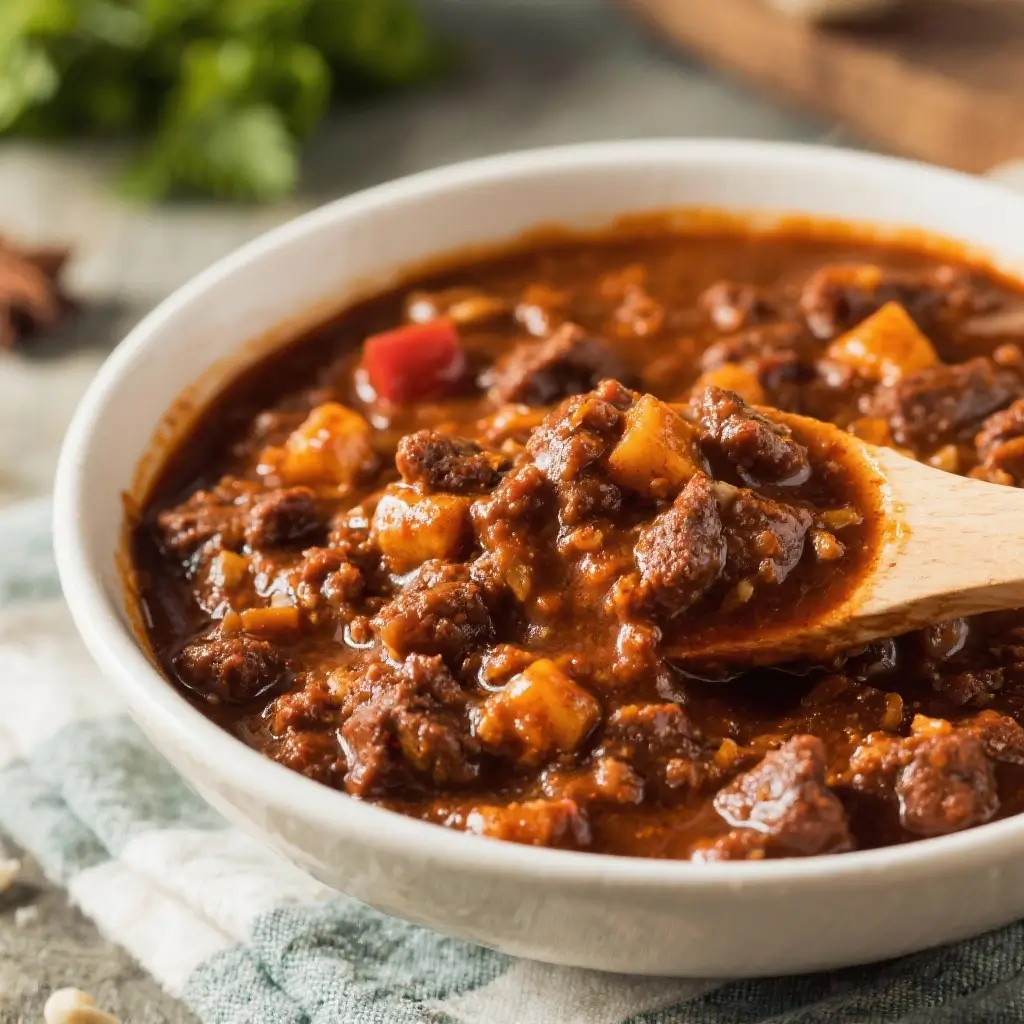Classic Beef Chili: A Hearty, Flavor-Packed Comfort Dish
There are few dishes that evoke the warmth and comfort of home quite like a steaming bowl of Classic Beef Chili. Rich, savory, and deeply satisfying, this timeless recipe has graced dinner tables across America for generations. Whether served on a chilly winter night, at a tailgate party, or as the star of a weeknight family meal, beef chili brings people together with its bold flavors and hearty texture. In this comprehensive guide, we’ll dive deep into the origins of this beloved dish, explore every ingredient in detail, provide a step-by-step recipe you can follow with confidence, offer expert tips and variations, examine nutritional aspects, and answer frequently asked questions to ensure your chili turns out perfect every time.
The History of Classic Beef Chili
The roots of Classic Beef Chili trace back to the early 19th century in Texas, where it emerged as a staple among cowboys, cattle drivers, and settlers. Known initially as “chili con carne,” which translates to “chili with meat” in Spanish, the dish was born out of necessity—using readily available ingredients such as dried beef, fat, and dried chili peppers. These early versions were simple, portable, and preserved well, making them ideal for life on the trail.
As immigrants from Germany and Eastern Europe arrived in Texas, they brought their culinary traditions, including sausage-making and stewing techniques, which helped evolve the original chili into a more complex and layered dish. By the late 1800s, chili stands began appearing in San Antonio, often operated by women known as “chili queens,” who served the spicy stew in public plazas and markets.
In the 20th century, chili gained national popularity. The invention of canned chili and the rise of chili cook-offs—especially the famous Terlingua International Chili Championship—helped cement its status as an American classic. Today, while regional variations abound—from Cincinnati-style with chocolate and cinnamon to Texas red without beans—Classic Beef Chili remains one of the most cherished and widely enjoyed forms of this iconic dish.
Ingredients Breakdown: What Makes This Chili Sing?
The magic of Classic Beef Chili lies not just in its bold taste but in the careful balance of ingredients that come together to create depth, heat, and richness. Here’s a detailed look at each component and its role in the final dish:
- Ground Beef (80/20 Lean-to-Fat Ratio): The foundation of the chili. Choosing ground beef with a slightly higher fat content ensures juiciness and helps carry the flavors of the spices. Chuck or brisket grind is ideal for maximum flavor.
- Yellow Onion: Provides a sweet, aromatic base when sautéed. Onions caramelize slightly during cooking, adding complexity and body to the sauce.
- Garlic: Freshly minced garlic delivers a pungent, earthy aroma and enhances the overall savoriness (umami) of the dish.
- Green Bell Pepper: Adds mild sweetness and a slight vegetal crunch. It balances the richness of the meat and contributes to the traditional “holy trinity” of chili vegetables (onion, pepper, garlic).
- Tomato Paste: Concentrated tomato flavor that thickens the chili and boosts umami. It’s caramelized briefly with the aromatics to deepen its taste.
- Canned Diced Tomatoes (with juice): Provide acidity, moisture, and a chunky texture. Opt for fire-roasted tomatoes for an extra layer of smokiness.
- Beef Broth or Stock: Adds savory depth and helps achieve the desired consistency. Homemade stock elevates the dish, but a low-sodium store-bought version works well too.
- Dark Beer (optional): A small amount of stout or porter enhances richness and adds subtle bitterness and malt notes that complement the beef. Can be substituted with additional broth if preferred.
- Kidney Beans (canned or cooked from dry): Add heartiness, fiber, and texture. Red kidney beans are traditional, though some purists argue against beans in authentic Texas chili. We include them for home-style appeal.
- Chili Powder: The backbone spice blend, typically containing ground chiles, cumin, garlic, and oregano. Quality matters—use a fresh, reputable brand.
- Ground Cumin: Earthy and warm, cumin is essential for that signature chili aroma and depth.
- Smoked Paprika: Adds a gentle smokiness without heat, enhancing the grilled, campfire-like quality of the chili.
- Cayenne Pepper: Introduces controlled heat. Adjust according to your spice tolerance.
- Dried Oregano: Offers a subtle herbal note that rounds out the spice profile.
- Unsweetened Cocoa Powder (optional): A secret weapon! Just a teaspoon deepens color and adds a nuanced bitterness that mimics slow-cooked richness.
- Bay Leaf: Imparts a floral, woodsy undertone that infuses the chili as it simmers.
- Salt and Black Pepper: Essential for balancing and enhancing all other flavors.
- Olive Oil or Vegetable Oil: Used for browning the meat and sautéing vegetables.
Step-by-Step Recipe: How to Make Perfect Classic Beef Chili
Follow this detailed method to create a rich, layered, and deeply flavorful batch of Classic Beef Chili that serves 6–8 people. Plan for about 1 hour of active cooking and simmering time.
- Prepare Ingredients: Dice the onion, bell pepper, and mince the garlic. Drain and rinse the kidney beans. Measure out all spices and have liquids ready.
- Brown the Beef: Heat 2 tablespoons of oil in a large heavy-bottomed pot or Dutch oven over medium-high heat. Add the ground beef in batches, breaking it apart with a wooden spoon. Cook until deeply browned (not gray), about 6–8 minutes per batch. Remove beef with a slotted spoon and set aside, leaving drippings in the pot.
- Sauté Aromatics: In the same pot, add the diced onion and bell pepper. Cook for 5–7 minutes until softened and beginning to caramelize. Stir in the garlic and cook for 30 seconds until fragrant.
- Bloom the Spices: Push vegetables to the side. Add tomato paste and let it cook undisturbed for 1–2 minutes to caramelize slightly. Then stir in chili powder, cumin, smoked paprika, cayenne, oregano, cocoa powder (if using), salt, and black pepper. Cook for 1 minute to toast the spices, releasing their essential oils.
- Combine and Deglaze: Return the browned beef to the pot. Stir to combine with the spiced vegetables. Pour in the dark beer (or broth) to deglaze the pan, scraping up any browned bits from the bottom—this is flavor gold!
- Add Liquids and Tomatoes: Stir in the diced tomatoes with their juice, beef broth, and bay leaf. Bring the mixture to a gentle boil.
- Simmer Low and Slow: Reduce heat to low, cover partially, and let the chili simmer for at least 45 minutes—ideally 1.5 to 2 hours. Stir occasionally to prevent sticking. The longer it simmers, the deeper the flavor becomes.
- Add Beans: Stir in the drained kidney beans during the last 30 minutes of cooking to prevent them from breaking down too much.
- Taste and Adjust: Remove the bay leaf. Taste the chili and adjust seasoning—add more salt, pepper, cayenne, or a splash of apple cider vinegar for brightness if needed.
- Rest Before Serving: Let the chili rest off heat for 10–15 minutes. This allows flavors to meld further.
Expert Tips for the Best Beef Chili
- Brown, Don’t Boil the Beef: Take time to sear the meat properly. Browning creates Maillard reactions, which add complex, meaty flavors.
- Toast Your Spices: Blooming spices in oil unlocks their full potential. Never skip this step—it makes a dramatic difference.
- Low and Slow Simmering: Rushing the process leads to flat flavors. Allow time for the chili to develop depth through extended simmering.
- Acidity is Key: If the chili tastes flat, brighten it with a splash of lime juice, apple cider vinegar, or even a bit of Worcestershire sauce.
- Fat = Flavor: Don’t drain all the fat after browning. Some should remain to carry fat-soluble flavor compounds from the spices.
- Make It Ahead: Chili tastes even better the next day. Prepare it a day in advance and reheat gently before serving.
- Freeze for Later: Portion and freeze chili for up to 3 months. Thaw overnight in the fridge and reheat on the stove.
Variations and Customizations
While Classic Beef Chili is delicious as-is, feel free to tailor it to your preferences or dietary needs:
- Texas-Style (No Beans): Omit beans entirely for a purist version. Focus on meat, tomatoes, and spices.
- White Chicken Chili: Swap beef for shredded chicken and use white beans, green chiles, and cumin-lime seasoning.
- Vegetarian/Vegan Chili: Replace beef with lentils, mushrooms, or textured vegetable protein. Use vegetable broth and plant-based Worcestershire.
- Spicy Jalapeño Kick: Add 1–2 diced fresh jalapeños (seeds removed for less heat) when sautéing vegetables.
- Smoky Chipotle Depth: Stir in 1–2 minced chipotle peppers in adobo sauce for intense smokiness and heat.
- Beer Variations: Try different beers—stout for richness, lager for crispness, or IPA for a hoppy twist.
- Sweet & Smoky Twist: Add a tablespoon of molasses or brown sugar for a touch of sweetness that balances the heat.
- Cincinnati-Style Influence: Add a pinch of ground cinnamon, a square of dark chocolate, and a dash of mustard for a unique regional flair.
- Slow Cooker Method: After browning meat and sautéing veggies, transfer everything to a slow cooker and cook on low for 6–8 hours.
- Instant Pot Version: Use the sauté function, then pressure cook on high for 20 minutes with a natural release.
Health Considerations and Nutritional Value
Classic Beef Chili can be both nutritious and indulgent, depending on preparation. Here’s a breakdown of its health profile per serving (approximately 1.5 cups):
| Nutrient | Amount (Approximate) |
| Calories | 320–380 |
| Protein | 25–30g |
| Total Fat | 15–20g |
| Saturated Fat | 6–8g |
| Carbohydrates | 20–25g |
| Dietary Fiber | 7–9g |
| Sugars | 6–8g (mostly natural from tomatoes and onions) |
| Sodium | 600–900mg (varies based on broth and added salt) |
| Iron | 20% of Daily Value |
| Zinc | 30% of Daily Value |
Health Benefits:
- High in protein for muscle repair and satiety.
- Rich in fiber from beans and vegetables, supporting digestive health.
- Packed with lycopene from tomatoes, a powerful antioxidant.
- Contains essential minerals like iron (for blood health) and zinc (for immunity).
Ways to Make It Healthier:
- Use lean ground beef (90/10) or ground turkey.
- Reduce added salt by using no-sodium broth and seasoning with herbs.
- Increase vegetables: Add diced carrots, celery, zucchini, or corn.
- Use low-sodium canned beans and rinse thoroughly.
- Omit optional sugar or beer to reduce empty calories.
Ingredients
- 2 tablespoons olive oil
- 2 pounds ground beef (80% lean)
- 1 large yellow onion, diced
- 1 green bell pepper, diced
- 4 cloves garlic, minced
- 3 tablespoons tomato paste
- 3 tablespoons chili powder
- 2 teaspoons ground cumin
- 1 teaspoon smoked paprika
- ½ teaspoon cayenne pepper (adjust to taste)
- 1 teaspoon dried oregano
- 1 teaspoon salt (plus more to taste)
- ½ teaspoon black pepper
- 1 teaspoon unsweetened cocoa powder (optional)
- 1 cup dark beer (such as stout) or beef broth
- 1 (28-ounce) can diced tomatoes (preferably fire-roasted)
- 2 cups beef broth (low-sodium preferred)
- 1 (15-ounce) can red kidney beans, drained and rinsed
- 1 bay leaf
Directions
- In a large Dutch oven or heavy pot, heat olive oil over medium-high heat.
- Add ground beef in batches, browning thoroughly. Remove and set aside.
- In the same pot, sauté onion and bell pepper until soft (5–7 minutes). Add garlic and cook 30 seconds.
- Stir in tomato paste and cook 1–2 minutes until darkened. Add all spices and toast for 1 minute.
- Return beef to pot. Stir in beer or broth to deglaze, scraping up browned bits.
- Add diced tomatoes, beef broth, and bay leaf. Bring to a boil, then reduce to a simmer.
- Cover partially and simmer for 1.5 to 2 hours, stirring occasionally.
- Add kidney beans in the last 30 minutes of cooking.
- Remove bay leaf. Adjust seasoning with salt, pepper, or acid if needed.
- Let rest 10–15 minutes before serving.
Frequently Asked Questions (FAQ)
Can I make beef chili without beans?
Yes! Traditional Texas chili skips beans entirely. Simply omit them and increase the meat or add extra vegetables for bulk.
How do I thicken my chili if it’s too thin?
You can simmer uncovered to reduce liquid, mash some beans and stir them in, or make a slurry with cornstarch and water (1 tbsp cornstarch + 2 tbsp water).
Can I freeze Classic Beef Chili?
Absolutely. Cool completely, then store in airtight containers for up to 3 months. Thaw in the refrigerator and reheat on the stove.
What’s the best way to reheat chili?
Reheat gently on the stovetop over medium-low heat, stirring occasionally and adding a splash of broth if needed. Microwave in 2-minute intervals, stirring in between.
Why does my chili taste flat?
It may need more salt, acid, or time. Add a pinch of salt, a squeeze of lime, or a dash of vinegar. Simmer longer to concentrate flavors.
Can I use different types of meat?
Yes. Try chuck roast (diced small and browned), ground turkey, Italian sausage, or a mix of meats for varied flavor.
How long does leftover chili last in the fridge?
Up to 4–5 days when stored in an airtight container.
Is chili healthy?
When made with lean meat, minimal added sugar, and plenty of vegetables, chili can be a balanced, nutrient-rich meal high in protein and fiber.
Summary
Classic Beef Chili is a rich, deeply flavorful dish rooted in Texan tradition, combining ground beef, aromatic vegetables, and a robust blend of spices simmered to perfection. Hearty, customizable, and even healthier when tweaked, it’s the ultimate comfort food for any season.










